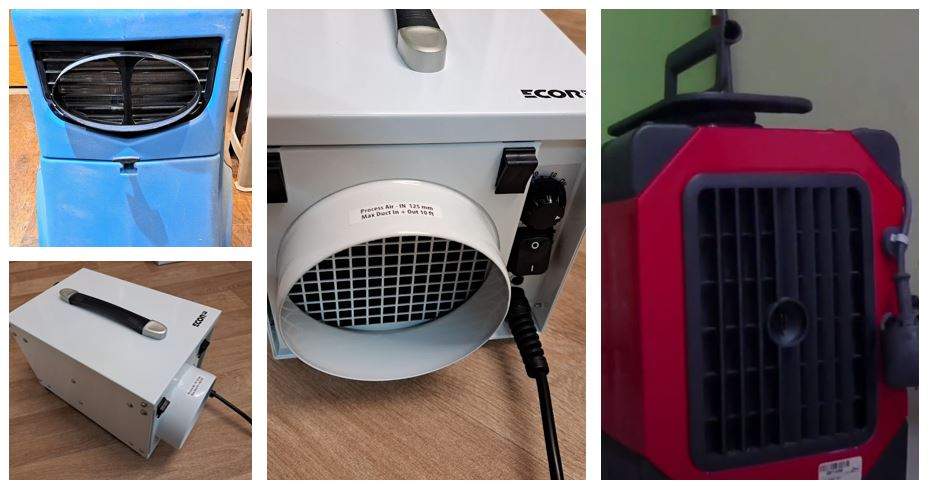Desiccant dehumidifiers, sometimes known as adsorption dehumidifiers, are one of the two common varieties of dehumidifier that is used in the water damage management restoration industry in the UK and around the world. The other category being refrigerant dehumidifiers (sometimes known as compressor dehumidifiers) which are also popular.
In this guide we will explain what a desiccant dehumidifier is, how it works and the advantages / disadvantages versus a refrigerant dehumidifier, especially in the UK climate applications.
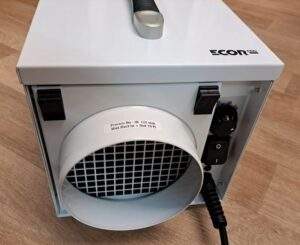
What is a Desiccant Dehumidifier?
The diagram below is a simplified model of a desiccant dehumidifier, which like all forms of dehumidifier, is designed to remove or reduce moisture from the air and surrounding materials (useful when drying after water leak or damp on a cold spot), in particular reducing relative humidity.
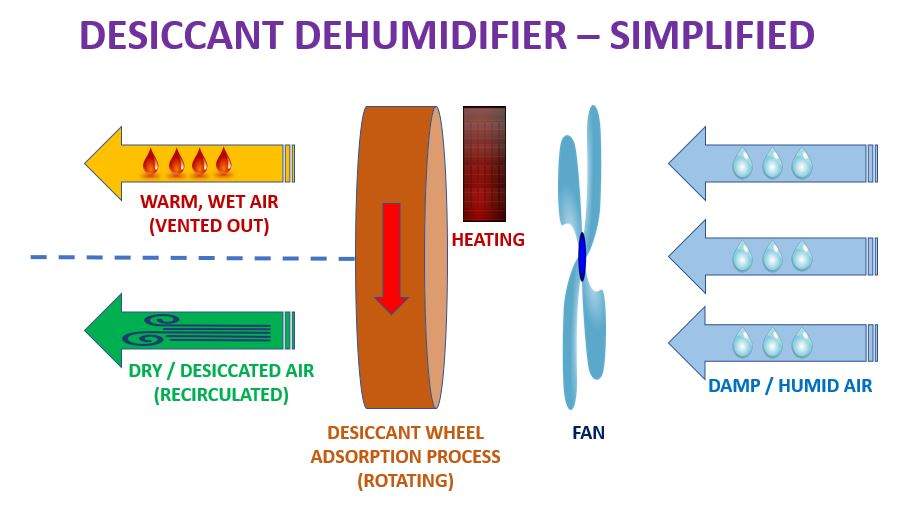
As you can see, there are several main components to it and although models from different manufacturers will vary in size layout, design and capacity (how much moisture they remove per hour). We will go into this in more detail, using a real desiccant dehumidifier diagram as an example.
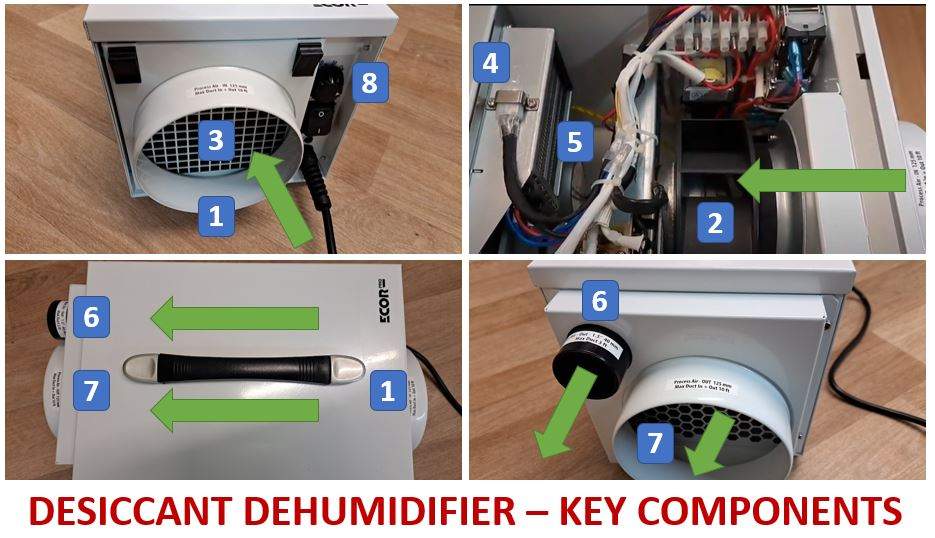
Desiccant Dehumidifier – Components
The main elements, as numbered in the pictures above are:
- Wet air input, drawing in air to be processed
- Fan to control air flow in and out of the desiccant
- Air filtration to remove dust and particles
- A rotating desiccant wheel, which traps moisture
- Heating elements to release the trapped moisture
- Wet /damp air extraction (in this case 40mm)
- Dry air extraction (in this case 125mm)
- Hydrostat to activate and deactivate the machine
- Ducting to direct the air flow (not shown here)
Although you can see there are quite a few elements to a desiccant dehumidifier. In some respects, their simplicity is their strength. With relatively few moving parts, a well looked after and regularly serviced dehumidifier can last many years.
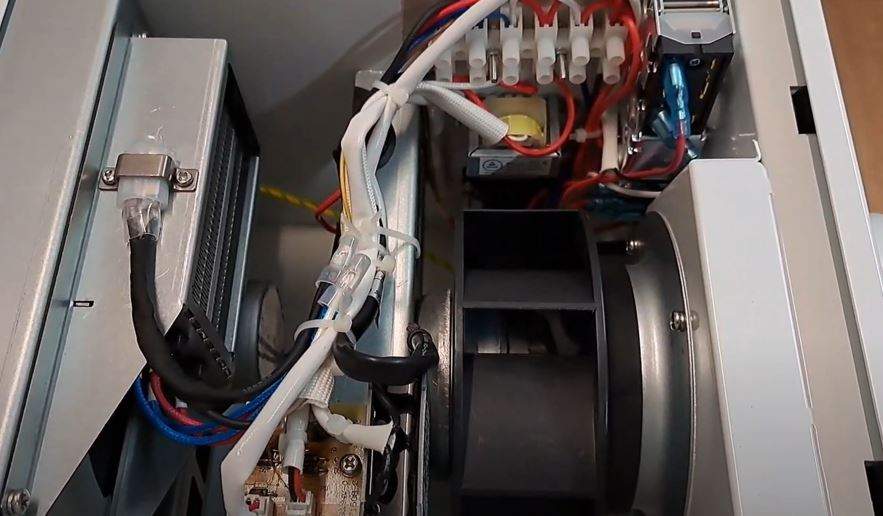
How Does a Desiccant Dehumidifier Work?
We covered above what all the key components of a desiccant dehumidifier are, but the obvious question is – how does it actually help to dry properties or reduce humidity?
Here are the stages to the process:
- Humid air is drawn in to the desiccant dehumidifier
- This moist air passes over a desiccant wheel
- The desiccant wheel ‘traps’ moisture within its structure
- This typically includes silicone material, like seen in silica gel
- The air exiting the other side is drier, desiccated air
- A section of the desiccated wheel is heated
- This causes the moisture on the surface to evaporate
- This is then extracted via a ‘wet’ outlet
- The process is repeated
- The air gets progressively drier until desired levels reached
Desiccant Dehumidifier Benefits
There are a number of things about how desiccants operate and function to remove moisture that can give them an advantage over refrigerant dehumidifiers in certain circumstances.
This includes:
- They can operate more effectively at lower temperatures
- This makes them good for winter months or properties without heating
- This can make them more economical out those temperatures
- They generally get up to operating efficiency much quicker
- They tend to be quieter than refrigerant dehumidifiers
- They can be better at removing moisture from certain materials
- Moisture is extracted as vapour rather than water
- They often produce drier air than refrigerants
As you can see desiccant dehumidifiers have a lot of benefits, however there are some potential downsides to them and situations where a refrigerant dehumidifier is preferential, which we will explain now in more detail. That said, some of these have been overcome with development in LGR Dehumidifiers (Low Grain Refrigerant).
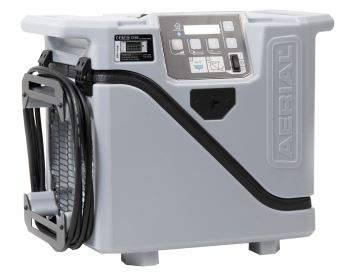
Desiccant Dehumidifier Cons
Although desiccant dehumidifiers are highly effective and have lots of benefits, as mentioned above, they do have some downsides:
- They can be trickier to set up an operate
- Especially as they often require ducting in and out
- Which may be more complicated than refrigerant draining
- In some situations venting the moist air can be problematic
- They can add more heat to a property (albeit only small amounts)
- In some situations they may be more costly to run
- You cannot easily measure how much moisture has been removed
Clearly many of the things listed above will vary according to the specific manufacturer and model of desiccant dehumidifier that is being used. In some situations both desiccant and refrigerant dehumidifiers can be used in conjunction with each other. However, typically one or other is chosen according to the situation, climatic conditions under the factors about the property and water leak in general. Especially after trace and access services requiring drying of water damage.
We have desiccant dehumidifiers suitable for a large range of domestic and commercial applications to help drive properties after a water leak or flood damage. Desiccant dehumidifiers can be small compact units for localised / target drying all large scale trailer drying systems for industrial all construction projects. These large scale units can remove a large amount of moisture from properties efficiently. To see what volumes of water can be involved – see our water leak loss calculator.
We also have an additional water use calculator which can be used alongside this.
Domestic Desiccant Dehumidifiers
When people are considering getting a dehumidifier for their domestic property, it’s generally more common that they will go down the route of a refrigerant model. However, with the rise in popularity of systems to help control damp, mould and condensation they are viable alternatives to PIV Units (Positive Input Ventilation Units).
This can be seen in the video below, where an Ecor Pro Desiccant Dehumidifier is explained:
Desiccant Dehumidifier Manufacturers
In this article we mentioned about Ecor Pro as a manufacturer of desiccant dehumidifiers, but here are a few other manufacturers commonly seen in the UK, each of whom have a wide range of machines:
We hope you found our guide to desiccant humidifiers useful if we can be of any assistance please do not hesitate to get in touch, especially if you need help with water leak detection.
Here are some other related articles you may find useful too:
- Dew Point Charts
- Humidity In Houses UK
- Shower Leak Causes
- Bathroom Leak Causes
- How To Find A Water Leak
Which is better dehumidifier desiccant or refrigerant?

Both desiccant and refrigerant dehumidifiers are excellent at removing moisture. In this article we explained the main pros and cons of each but, in a nutshell, desiccants are generally better in colder conditions (but can require more setup and venting). In comparison, refrigerant dehumidifiers are often simpler to setup and use but have a lower operating range to get optimal results and may require additional heating in winter to aid this.
Do desiccant dehumidifiers heat the room?

Desiccant dehumidifiers do commonly include a small heating element within them so, yes they can and do add heat to a room. However, relatively speaking this is only a small amount of focused heat and that heated air is often vented externally out of the property as warm, humid air to aid the drying process within the location they are installed.
